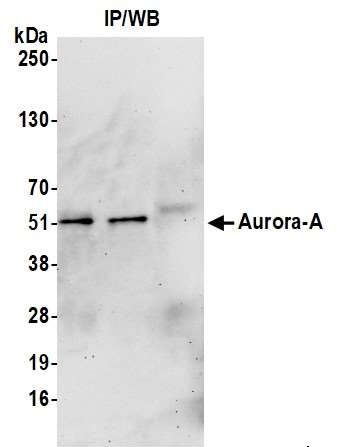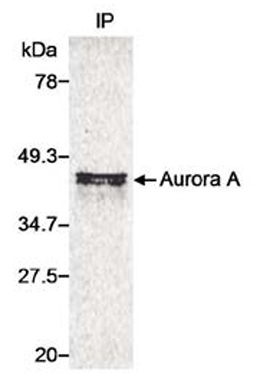Anti-Aurora A/STK15 [Polyclonal]
Anti-Aurora A/STK15 [Polyclonal]
Product No.: 13040
- -
- -
Target Aurora A/STK15 Product Type Polyclonal Alternate Names EC 2.7.11.1, Aurora 2, Aurora/IPL1-related kinase 1, ARK-1, Aurora-related kinase 1, hARK1, Breast tumor-amplified kinase, Serine/threonine-protein kinase 15, Serine/threonine-protein kinase 6, Serine/threonine-protein kinase aurora-A Isotype Whole IgG Applications IP |
Data
 Detection of human Aurora A by western blot of immunoprecipitates. Samples: Whole cell lysate (1.0 mg per IP reaction; 20% of IP loaded) from HeLa cells prepared using NETN lysis buffer. Antibodies: Affinity purified rabbit anti-Aurora A antibody 13040 (lot 13040-6) used for IP at 6 µg per reaction. Aurora A was also immunoprecipitated by a previous lot of this antibody (lot 13040-1). For blotting immunoprecipitated Aurora A
Detection of human Aurora A by western blot of immunoprecipitates. Samples: Whole cell lysate (1.0 mg per IP reaction; 20% of IP loaded) from HeLa cells prepared using NETN lysis buffer. Antibodies: Affinity purified rabbit anti-Aurora A antibody 13040 (lot 13040-6) used for IP at 6 µg per reaction. Aurora A was also immunoprecipitated by a previous lot of this antibody (lot 13040-1). For blotting immunoprecipitated Aurora A - -
- -
Antibody DetailsProduct DetailsReactivity Species Human Host Species Rabbit Immunogen Synthetic peptide representing a portion of the protein encoded within exon 5. Product Concentration Lot Specific Formulation Tris-citrate/phosphate buffer, pH 7 to 8 containing 0.09% Sodium Azide State of Matter Liquid Product Preparation Purified by antigen immunoaffinity chromatography Storage and Handling This antibody is stable at 2 - 8°C for one (1) year from date of receipt. Country of Origin USA Shipping Next Day 2-8°C Applications and Recommended Usage? Quality Tested by Leinco Immunoprecipitation: 2-10ug/mg lysate. These are recommended concentrations. Endusers should determine optimal concentrations for their applications. Each investigator should determine their own optimal working dilution for specific applications. See directions on lot specific datasheets, as information may periodically change. DescriptionSpecificity This antibody reacts with human Aurora kinase A, and the epitope recognized maps to a region between residues 50-100 of human Aurora kinase A. Based on 100% sequence identity this antibody is predicted to react with chimpanzee, crab-eating macaque, and Northern white-cheeked gibbon. Background Aurora kinase A, also known as serine/threonine-protein kinase 6, is an enzyme that in humans is encoded by the AURKA gene. Aurora A is a member of a family of mitotic serine/threonine kinases associated with important processes during mitosis and meiosis. Aurora A is activated by one or more phosphorylations, and its activity peaks during the G2 phase to M phase transition in the cell cycle. Aurora A dysregulation has been associated with high occurrence of cancer. Antigen DetailsFunction Mitotic serine/threonine kinase that contributes to the regulation of cell cycle progression (PubMed:26246606, PubMed:12390251, PubMed:18615013, PubMed:11039908, PubMed:17125279, PubMed:17360485). Associates with the centrosome and the spindle microtubules during mitosis and plays a critical role in various mitotic events including the establishment of mitotic spindle, centrosome duplication, centrosome separation as well as maturation, chromosomal alignment, spindle assembly checkpoint, and cytokinesis (PubMed:26246606, PubMed:14523000). Required for normal spindle positioning during mitosis and for the localization of NUMA1 and DCTN1 to the cell cortex during metaphase (PubMed:27335426). Required for initial activation of CDK1 at centrosomes (PubMed:13678582, PubMed:15128871). Phosphorylates numerous target proteins, including ARHGEF2, BORA, BRCA1, CDC25B, DLGP5, HDAC6, KIF2A, LATS2, NDEL1, PARD3, PPP1R2, PLK1, RASSF1, TACC3, p53/TP53 and TPX2 (PubMed:18056443, PubMed:15128871, PubMed:14702041, PubMed:11551964, PubMed:15147269, PubMed:15987997, PubMed:17604723, PubMed:18615013). Regulates KIF2A tubulin depolymerase activity (PubMed:19351716). Important for microtubule formation and/or stabilization (PubMed:18056443). Required for normal axon formation (PubMed:19812038). Plays a role in microtubule remodeling during neurite extension (PubMed:19668197). Also acts as a key regulatory component of the p53/TP53 pathway, and particularly the checkpoint-response pathways critical for oncogenic transformation of cells, by phosphorylating and destabilizing p53/TP53 (PubMed:14702041). Phosphorylates its own inhibitors, the protein phosphatase type 1 (PP1) isoforms, to inhibit their activity (PubMed:11551964). Necessary for proper cilia disassembly prior to mitosis (PubMed:17604723, PubMed:20643351). Regulates protein levels of the anti-apoptosis protein BIRC5 by suppressing the expression of the SCF(FBXL7) E3 ubiquitin-protein ligase substrate adapter FBXL7 through the phosphorylation of the transcription factor FOXP1 (PubMed:28218735). {PubMed:11039908, PubMed:11551964, PubMed:12390251, PubMed:13678582, PubMed:14523000, PubMed:14702041, PubMed:15128871, PubMed:15147269, PubMed:15987997, PubMed:17125279, PubMed:17360485, PubMed:17604723, PubMed:18056443, PubMed:18615013, PubMed:19351716, PubMed:19668197, PubMed:19812038, PubMed:20643351, PubMed:26246606, PubMed:27335426, PubMed:28218735}. NCBI Gene Bank ID UniProt.org Research Area Enzymes References & CitationsTechnical Protocols |
 Products are for research use only. Not for use in diagnostic or therapeutic procedures.
Products are for research use only. Not for use in diagnostic or therapeutic procedures.



